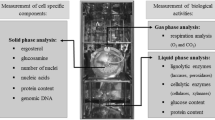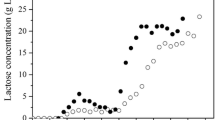Abstract
A process that combines the advantages of solid state fermentation (SSF) and submerged fermentation (SmF) could increase the efficiency of cellulase production required in the cellulosic ethanol industry. Due to the difficulty of measuring cellular biomass in the presence of solids, we developed a novel methodology for indirect quantification of biomass during production of the preculture for a combined fermentation process. Cultivation of Aspergillus niger was initiated as SSF using sugar cane bagasse as a solid substrate. Experiments were conducted in the absence of bagasse to determine growth kinetic parameters. Changes in glucose and biomass concentrations were measured. and the data were used for simulation employing a simple unstructured model. Parameters were estimated by applying a combination of Simulated Annealing (SA) and Levenberg-Marquardt (LM) algorithms to search for minimization of the error between model estimates and experimental data. Growth kinetics followed the Contois model, with a maximum specific growth rate (μmax) of 0.042/h, a yield coefficient for biomass formation (Yx/s) of 0.30 g/g and a death constant (kD) of 0.005/h.These parameters were used to simulate cellular growth in the solids-containing medium. The proposed model accurately described the experimental data and succeeded in simulating the cell concentration profile. The selected pre-culture conditions (24 h as SSF followed by 48 h as SmF) were applied for cellulase production using the combined fermentation process and resulted in an endoglucanase activity (1,052 ± 34 U/L) greater than that obtained using the conventional SmF procedure (824 ± 44 U/L). Besides the standardization of pre-culture conditions, this methodology could be very useful in systems where direct measurement of cell mass is not possible.
Similar content being viewed by others
References
Lynd, L. R. (1996) Overview and evaluation of fuel ethanol from cellulosic biomass: Technology, economics, the environment, and policy. Annu. Rev. Energy Environ. 21: 403–465.
Wilson, D. B. and D. C. Irwin (1999) Genetics and properties of cellulases. Adv. Biochem. Eng. Biotechnol. 65: 1–21.
Zhang, Y. -H. P. and L. R. Lynd (2004) Toward an aggregated understanding of enzymatic hydrolysis of cellulose: Noncomplexed cellulase systems. Biotechnol. Bioeng. 88: 797–824.
Kubicek, C. P., M. Mikus, A. Schuster, M. Schmoll, and B. Seiboth (2009) Metabolic engineering strategies for the improved of cellulase production by Hypocrea jecorina. Biotechnol. Biofuels 2: 19.
Raimbault, M. (1998) General and microbiological aspects of solid substrate fermentation. Eletron. J. Biotechn. 1: 3–45.
Acuna-Arguelles, M. E., M. Gutierrez-Rojas, G. Viniegra-González, and E. Favela-Torres (1995) Production and properties of three pectinolytic activities produced by Aspergillus niger in submerged and solid-state fermentation. Appl. Microbiol. Biotechnol. 43: 808–814.
Saqib, A. A. N., M. Hassan, N. F. Khan, and S. Baig (2010) Thermostability of crude endoglucanase from Aspergillus fumigatus grown under solid state fermentation (SSF) and submerged fermentation (SmF). Proc. Biochem. 45: 641–646.
Singhania, R. R., R. K. Sukumaran, A. K. Patel, C. Larroche, and A. Pandey (2010) Advancement and comparative profiles in the production technologies using solid-state and submerged fermentation for microbial cellulases. Enz. Microb. Tech. 46: 541–549.
Villena, G. K., T. Fujikawa, S. Tsuyumu, and M. Gutiérrez-Correa (2009) Differential gene expression of some lignocellulolytic enzymes in Aspergillus niger biofilms. Rev. Peru Biol. 15: 97–102.
Lynd, L. R., P. J. Weimer, W. H. van Zyl, and I. S. Pretorius (2002) Microbial cellulose utilization: fundamentals and biotechnology. Microbiol. Mol. Biol. Rev. 66: 506–577.
Domingues, F.C., J. A. Queiroz, J. M. Cabral, and L. P. Fonseca (2000) The influence of culture conditions on mycelial structure and cellulase production by Trichoderma reesei Rut C-30. Enz. Microb. Tech. 26: 394–401.
Kennedy, M. J., M. S. Thakur, D. I. C. Wang, and G. N. Stephanopoulos (1992) Techniques for the estimation of cell concentration in the presence of suspended solids. Biotechnol. Prog. 8: 375–381.
Carvalho, J. C., A. Pandey, B. O. Oishi, D. Brand, J. A. Rodriguez-Léon, and C. R. Soccol (2006) Relation between growth, respirometric analysis and biopigments production from Monascus by solid-state fermentation. Biochem. Eng. J. 29: 262–269.
Prado, F. C., L. R. S. Vandenberghe, C. Lisboa, J. Paca, A. Pandey, and C. R. Soccol (2004) Relation between citric acid production and respiration rate of Aspergillus niger in solid-state fermentation. Eng. Life Sci. 4: 179–186.
Koutinas, A. A., R. Wang, and C. Webb (2003) Estimation of fungal growth in complex, heterogeneous culture. Biochem. Eng. J. 14: 93–100.
Ooijkaas, L. P., J. Tramper, and R. M. Buitelaar (1998) Biomass estimation of Coniothyrium minitans in solid-state fermentation. Enz. Microb. Tech. 22: 480–486.
Scotti, C. T., C. Vergoignan, G. Feron, and A. Durand (2001) Glucosamine measurement as indirect method for biomass estimation of Cunninghamella elegans grown in solid state cultivation conditions. Biochem. Eng. J. 7: 1–5.
Osma, J. F., J. L. Toca-Herrera, and S. Rodriguez-Couto (2011) Environmental, scanning electron and optical microscope image analysis software for determining volume and occupied area of solid-state fermentation fungal cultures. Biotechnol. J. 6: 45–55.
Couri, S., E. P. Merces, B. C. V. Neves, and L. F. Senna (2006) Digital image processing as a tool to monitor biomass growth in Aspergillus niger 3T5B8 solid-state fermentation: Preliminary results. J. Microsci. 224: 290–297.
Terebiznik, M. R. and A. M. R. Pilosof (1999) Biomass estimation in solid state fermentation by modeling dry matter weight loss. Biotechnol. Tech. 13: 215–219.
Gill, N. K., M. Appleton, and G. J. Lye (2008) Thermal profiling for parallel on-line monitoring of biomass growth in miniature stirred bioreactors. Biotechnol. Lett. 30: 1571–1575.
Hongquiang, L. and C. Hongzhang (2008) Near-infrared spectroscopy with a fiber-optic probe for state variables determination in solid-state fermentation. Proc. Biochem. 43: 511–516.
Mitchell, D. A. (1992) Growth patterns growth kinetics and the modelling of growth in solid-state-cultivation. pp. 87–112. In: H. W. Doelle, D. A. Mitchell, and C. E. Rolz (eds.). Solid Substrate Cultivation. Amsterdam: Elsevier Science Publishers.
Moles, C. G., P. Mendes, and J. R. Banga (2003) Parameter estimation in biochemical pathways: a comparison of global optimization methods. Genome Res. 13: 2467–2474.
Rodriguez-Fernandez, M., P. Mendes, and J. R. Banga (2006) A hybrid approach for efficient and robust parameter estimation in biochemical pathways. BioSystems 83: 248–265.
Silva, R. G., A. J. G. Cruz, C. O. Hokka, R. L. C. Giordano, and R. C. Giordano (2001) A hybrid neural network algorithm for online state inference that accounts for differences in inoculum of Cephalosporium acremonium in fed-batch fermentors. Appl. Biochem. Biotechnol. 91–93: 341–352.
Gernaey, K. V., A. E. Lantz, P. Tufvesson, J. M. Woodley, and G. Sin (2007) Application of mechanistic models to fermentation and biocatalysis for next-generation processes. Appl. Biochem. Biotechnol. 143: 142–152.
Couri, S. and A. X. Farias (1995) Genetic manipulation of Aspergillus niger for increased synthesis of pectinolytic enzymes. Revista de Microbiologia 26: 314–317.
Mandels, M. and D. Sternberg (1976) Recent advances in cellulases technology. J. Ferment. Technol. 54: 267–286.
Montera, L., A. C. L. Horta, T. C. Zangirolami, M. C. Nicoletti, T. S. Carmo, and V. M. Gonçalves (2008) A heuristic search for optimal parameter values of three biokinetic growth models for describing batch cultivations of Streptococcus pneumoniae in bioreactors. Lect. Notes Comput. Sci. 5027: 359–368.
Nelles, O. (2001) Nonlinear System Identification: From Classical Approaches to Neural Networks and Fuzzy Models. Springer, Germany.
Shuler, M. L. and F. Kargi (2002) Bioprocess engineering: Basic concepts. Prentice Hall, Englewood Cliffs.
Ghose, T. K. (1987) Measurement of cellulase activities. Pure Appl. Chem. 59: 257–268.
Miller, G. L. (1959) Use of dinitrosalicilic acid reagent for determination of reducing sugar. Anal. Chem. 31: 426–428.
Castro, A. M., K. C. N. R. Pedro, Cruz, J. C. Da, M. C. Ferreira, S. G. F. Leite, and N. Pereira Jr. (2010) Trichoderma harzianum IOC-4038: A promising strain for the production of a cellulolytic complex with significant β-glucosidase activity from sugarcane bagasse cellulignin. Appl. Biochem. Biotechnol. 162: 2111–2122.
Author information
Authors and Affiliations
Corresponding author
Rights and permissions
About this article
Cite this article
Cunha, F.M., Bacchin, A.L.G., Horta, A.C.L. et al. Indirect method for quantification of cellular biomass in a solidscontaining medium used as pre-culture for cellulase production. Biotechnol Bioproc E 17, 100–108 (2012). https://doi.org/10.1007/s12257-011-0405-z
Received:
Revised:
Accepted:
Published:
Issue Date:
DOI: https://doi.org/10.1007/s12257-011-0405-z




